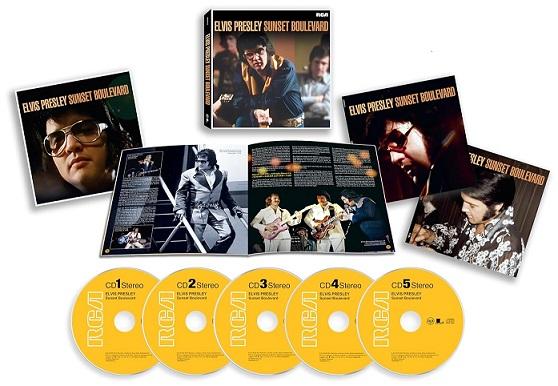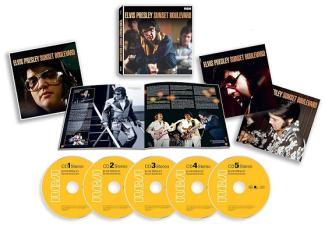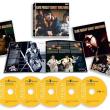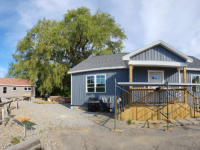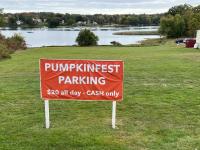Another Presley box set and live Peter Gabriel
Elvis Presley: Sunset Boulevard (RCA/Legacy, 5 CDs, 5 hours 28 min.). This is a comprehensive 5-CD collection that spotlights Presley’s recording sessions and rehearsals at RCA’s historic Sunset Boulevard Studio. Spanning 1970 to 1975, it features Presley recording for the first time with his legendary touring band. The sessions spawned the hits “Burning Love,” “Always on My Mind” (1972) and “T-R-O-U-B-L-E” (1975) from the “Today” album. This new set includes three discs of rehearsals from 1970 and 1974 that capture both serious and light-hearted moments from Presley in the studio. There are 89 tracks in all, 34 of which are newly-mixed versions, without overdubs.
There are rare alternate studio versions of his late-period gems: “Separate Ways,” widely seen as the most autobiographical song Presley ever recorded; “T-R-O-U-B-L-E,” the fun number which channeled the groundbreaking rockabilly vocal style of his earlier years; and “Burning Love,” the 40th and final Top Ten single of his career. Another powerful highlight is “Always on My Mind,” which stands as one of Presley’s most emotionally resonant recordings from his 1970s sessions. Though widely popularized by Willie Nelson a decade later, the song, originally penned by Wayne Carson, Johnny Christopher and Mark James, in Presley’s version, captures its raw vulnerability with striking depth.
The collection’s first two discs -- also released as a standalone 2 LP highlights set with a curated selection of standouts and outtakes -- feature new and never-heard mixes from four-time Grammy-winner Matt Ross-Spang, who stripped all overdubs, delivering fresh insights in the process.
Disc one contains the masters of 17 classics from throughout Elvis’ time in RCA Studio C. Among them are Kris Kristofferson’s “For the Good Times,” a 1972 B-side, first released in 1995; Paul Williams’ “Where Do I Go from Here,” from 1973’s “Elvis” album; Billy Swan’s upbeat “I Can Help,” from 1975’s “Today” album; and Don McLean’s “And I Love You So,” also from “Today.” There also is Presley’s version of “Green, Green Grass of Home.”
Ross-Spang’s stripped-down mixes equally bolster the 17 studio outtakes – mostly alternate takes -- that comprise the set’s second disc. Highlights include “Separate Ways,” “Where Do I Go from Here,” “Burning Love” (with more wah-wah guitar) and “Always on My Mind.” There are three false starts on the first of two attempts at “It’s a Matter of Time.” Other false starts are heard on “Green, Green Grass of Home,” “Susan When She Tried” and “Pieces of My Life.”
The final three discs offer a behind-the-scenes look at Presley’s history-making Las Vegas residency. There are Los Angeles rehearsals from July 24, 1970 and August 16, 1974 with his iconic TCB Band. Elvis’ effortless chemistry with The TCB Band is palpable throughout both rehearsals, probably owing to his decision to record with a road band for the first time during this era.
The rehearsals, especially the looser 1974 ones, show a relaxed Presley. Discs three and four contain 34 tracks from 1970, including a galloping “That’s All Right,” an upbeat “I Can’t Stop Loving You” and covers of “You’ve Lost That Lovin’ Feeling,” “Polk Salad Annie,” “Bridge Over Troubled Water,” “Sweet Caroline” and “Jonny B. Goode.” Discs four and five contain 21 tracks – six songs have two different tries – from the 1974 rehearsal.
The set comes with a 28-page, nicely illustrated booklet, with an introduction by Jerry Schilling, as well as notes on the recordings and songwriter stories. Grade: box set B+
Peter Gabriel: Taking the Pulse (Mercury Studios, Blu-ray, NR, 97 min.). This concert film was recorded under the stars at the Arena di Verona in Italy on Sept. 26, 2010. At the time, Gabriel, originally the frontman for Genesis until 1975, was going through a period in which he was working with an orchestra. In 2010, he released the orchestral album “Scratch My Back,” an album of covers that he hoped would lead the covered artists to recording a cover of one of his songs in return, and then 2011’s “New Blood,” which contained re-recordings of 14 of his songs performed with an orchestra.
Twelve of the 14 songs on “New Blood” are covered in this concert, along with four others for a total of 16. Gabriel takes the stage with 50 musicians from The New Blood Orchestra, conducted by Ben Foster. They, along with vocalists Melanie Gabriel, his daughter, and Norway’s Ane Brun, deliver new arrangements by John Metcalfe of classic Gabriel songs, following the rule of no guitars and no rock drums.
The film is directed by Anna Gabriel, his other daughter. Peter Gabriel and The New Blood Orchestra perform against a backdrop of massive screens projecting animations and visuals that are more abstract usually than touch on the subjects of the songs, “Blood of Eden” being an exception.
The show opens with the thunderous intensity of “Rhythm of the Heat,” set to an image of the song’s music sheet burning. After “San Jacinto,” Gabriel sings about “places I got hurt” in “Digging in the Dirt,” which is dramatic with the string section. “Downside Up,” the sixth song, starts with Brun singing, then joined by Peter Gabirel on the chorus. It is the first really upbeat song, after several lugubrious numbers, including “Signal to Noise.” More haunting is “Intruder,” another dramatic number with its piano, strings and use of a large orchestral drum.
As the concert progresses, it includes more familiar songs, and thus is more appealing. These include “Red Rain,” which is more rock; his classic “Solsbury Hill,” his first solo release after leaving Genesis and on which the crowd joins clapping throughout; “In Your Eyes,” the first of three encore songs; and “Don’t Give Up,” which Brun co-sings.
The Blu-ray comes with an 8-page booklet of credits and color photos. Grade: Blu-ray B
1!2!3!4! The Ramones Atmos Collection (Sire/Rhino, 4 Blu-rays). Rhino presents the first four Ramones albums in Dolby Atmos on Blu-ray for the first time in this box set. Limited to 2,000 copies, it is available exclusively at Rhino.com and WMG stores internationally. The four albums are “Ramones,” “Leave Home” “Rocket to Russia” and “Road to Ruin.”
The Blu-ray audio set also features each album's original stereo mixes, now in hi-resolution. Ed Stasium, who originally engineered three of the albums, created the Atmos mixes for “Leave Home,” “Rocket to Russia” and “Road to Ruin.” Craig Leon, who produced the band’s 1976 debut, contributed the Atmos mix for “Ramones.”
“These Atmos mixes present the Ramones’ recordings with the clarity and power with which I always imagined hearing them,” Stasium said in a press release. “It might sound a bit cliché, but I find listening to them to be like seeing the sequence from ‘The Wizard of Oz’ where the film morphs from black and white to color. These Dolby Atmos mixes are transforming the original mixes from 16mm black and white into vivid IMAX.”
Formed in Queens, N.Y., the Ramones -- Joey Ramone on vocals, Johnny Ramone on guitar, Dee Dee Ramone on bass and Tommy Ramone on drums -- stripped rock to its core and helped ignite the punk movement. Their 1976 self-titled debut is fast, loud and relentless, cutting through the era’s excess with buzzsaw guitars and a defiant attitude. It was highlighted by “Blitzkrieg Bop” and “Judy Is a Punk.”
“Leave Home” arrived soon after, delivering sharper pacing and a stronger sonic punch, built on that momentum. Highlights include “Carbona Not Glue,” “Suzie Is a Headbanger” and “California Sun.”
Also in 1977, “Rocket to Russia,” which combined early rock ’n’ roll influences with a harder edge, included “Cretin Hop,” “Rockaway Beach,” “Sheena Is a Punk Rocker,” “Teenage Lobotomy” and their cover of “Do You Wanna Dance?”
By the time “Road to Ruin” arrived in 1978, Marky Ramone had joined on drums as the band embraced a more ambitious approach that carried their sound into new territory. Highlights are “I Wanna Be Sedated” and “I’m Against It.” Grade: box set A+
About this blog:

My music review column, Playback, first ran in February 1972 in The Herald newspapers of Paddock Publications in Arlington Heights, IL. It moved to The Camden Herald in 1977 and to The Courier Gazette in 1978, where it was joined by my home video reviews in 1993. The columns ran on VillageSoup for awhile, but now have this new home. I worked at the Courier Gazette for 29 years, half that time as Sports Editor. Recently, I was a selectman in Owls Head for nine years.

